3D Object Detection via 2D Segmentation-Based Computational Integral Imaging Applied to a Real Video
Abstract
:1. Introduction
1.1. Previous Related Works
1.2. The Proposed Contribution
2. Computational Integral Imaging (CII) Analysis for Depth Data Formation
Locating Depths Where Large Objects Exist in the Reconstructed Planes
3. Proposed Method for 3D Object Detection and Segmentation
3.1. Capturing Elementals Videos (EVs) with a Camera Array
3.2. 2D Object Detection via Instance Segmentation
3.3. Finding Objects’ Depth Locations via CII Analysis in Objects’ Tubes
4. Experimental Results
Comparison with the Previous Method
5. Conclusions
Author Contributions
Funding
Institutional Review Board Statement
Informed Consent Statement
Data Availability Statement
Conflicts of Interest
References
- Aguiar, A.P.; Hespanha, J.P. Trajectory-Tracking and Path-Following of Underactuated Autonomous Vehicles With Parametric Modeling Uncertainty. IEEE Trans. Automat. Contr. 2007, 52, 1362–1379. [Google Scholar] [CrossRef]
- Hosseinyalamdary, S.; Balazadegan, Y.; Toth, C. Tracking 3D Moving Objects Based on GPS/IMU Navigation Solution, Laser Scanner Point Cloud and GIS Data. ISPRS Int. J. Geo-Inf. 2015, 4, 1301–1316. [Google Scholar] [CrossRef]
- Reiter, A.; Allen, P.K.; Zhao, T. Appearance Learning for 3D Tracking of Robotic Surgical Tools. Int. J. Robot. Res. 2014, 33, 342–356. [Google Scholar] [CrossRef]
- Sebe, I.O.; Hu, J.; You, S.; Neumann, U. 3D Video Surveillance with Augmented Virtual Environments. In Proceedings of the First ACM SIGMM International Workshop on Video Surveillance—IWVS’03, New York, NY, USA, 2–8 November 2003; ACM Press: Berkeley, California, 2003; p. 107. [Google Scholar]
- Jung, J.-H.; Aloni, D.; Yitzhaky, Y.; Peli, E. Active Confocal Imaging for Visual Prostheses. Vis. Res. 2015, 111, 182–196. [Google Scholar] [CrossRef] [PubMed]
- Avraham, D.; Yitzhaky, Y. Effects of Depth-Based Object Isolation in Simulated Retinal Prosthetic Vision. Symmetry 2021, 13, 1763. [Google Scholar] [CrossRef]
- Lippmann, G. La Photographie Integrale. Comptes-Rendus 1908, 146, 446–451. [Google Scholar]
- Stern, A.; Javidi, B. Three-Dimensional Image Sensing, Visualization, and Processing Using Integral Imaging. Proc. IEEE 2006, 94, 591–607. [Google Scholar] [CrossRef]
- Li, X.-W.; Lee, I.-K. Modified Computational Integral Imaging-Based Double Image Encryption Using Fractional Fourier Transform. Opt. Lasers Eng. 2015, 66, 112–121. [Google Scholar] [CrossRef]
- Xiao, X.; Javidi, B.; Martinez-Corral, M.; Stern, A. Advances in Three-Dimensional Integral Imaging: Sensing, Display, and Applications. Appl. Opt. 2013, 52, 546–560. [Google Scholar] [CrossRef] [PubMed]
- Hong, S.; Shin, D.; Lee, B.-G.; Dorado, A.; Saavedra, G.; Martínez-Corral, M. Towards 3D Television through Fusion of Kinect and Integral-Imaging Concepts. J. Disp. Technol. 2014, 11, 894–899. [Google Scholar] [CrossRef]
- Navarro, H.; Saavedra, G.; Martínez-Corral, M.; Sjöström, M.; Olsson, R. Depth-of-Field Enhancement in Integral Imaging by Selective Depth-Deconvolution. J. Disp. Technol. 2013, 10, 182–188. [Google Scholar] [CrossRef]
- Markman, A.; Wang, J.; Javidi, B. Three-Dimensional Integral Imaging Displays Using a Quick-Response Encoded Elemental Image Array. Optica 2014, 1, 332–335. [Google Scholar] [CrossRef]
- Bae, J.; Yoo, H. Image Enhancement for Computational Integral Imaging Reconstruction via Four-Dimensional Image Structure. Sensors 2020, 20, 4795. [Google Scholar] [CrossRef]
- Lee, J.; Cho, M. Three-Dimensional Integral Imaging with Enhanced Lateral and Longitudinal Resolutions Using Multiple Pickup Positions. Sensors 2022, 22, 9199. [Google Scholar] [CrossRef]
- Wang, J.; Xiao, X.; Hua, H.; Javidi, B. Augmented Reality 3D Displays with Micro Integral Imaging. J. Disp. Technol. 2015, 11, 889–893. [Google Scholar] [CrossRef]
- Hansard, M.; Lee, S.; Choi, O.; Horaud, R. Time-of-Flight Cameras: Principles, Methods and Applications; SpringerBriefs in Computer Science; Springer: London, UK, 2013; ISBN 978-1-4471-4657-5. [Google Scholar]
- Geng, J. Structured-Light 3D Surface Imaging: A Tutorial. Adv. Opt. Photonics 2011, 3, 128–160. [Google Scholar] [CrossRef]
- Lang, M.; Hornung, A.; Wang, O.; Poulakos, S.; Smolic, A.; Gross, M. Nonlinear Disparity Mapping for Stereoscopic 3D. ACM Trans. Graph. 2010, 29, 1–10. [Google Scholar] [CrossRef]
- Stern, A.; Aloni, D.; Javidi, B. Experiments with Three-Dimensional Integral Imaging under Low Light Levels. IEEE Photonics J. 2012, 4, 1188–1195. [Google Scholar] [CrossRef]
- Usmani, K.; O’Connor, T.; Wani, P.; Javidi, B. 3D Object Detection through Fog and Occlusion: Passive Integral Imaging vs Active (LiDAR) Sensing. Opt. Express 2023, 31, 479–491. [Google Scholar] [CrossRef] [PubMed]
- Frauel, Y.; Javidi, B. Digital Three-Dimensional Image Correlation by Use of Computer-Reconstructed Integral Imaging. Appl. Opt. 2002, 41, 5488–5496. [Google Scholar] [CrossRef]
- Yeom, S.; Lee, D.; Son, J.-Y.; Kim, S.-H. Three-Dimensional Object Reconstruction and Recognition Using Computational Integral Imaging and Statistical Pattern Analysis. Jpn. J. Appl. Phys. 2009, 48, 09LB05. [Google Scholar] [CrossRef]
- Lee, J.-J.; Lee, B.-G.; Yoo, H. Depth Extraction of Three-Dimensional Objects Using Block Matching for Slice Images in Synthetic Aperture Integral Imaging. Appl. Opt. 2011, 50, 5624–5629. [Google Scholar] [CrossRef]
- Tao, M.W.; Hadap, S.; Malik, J.; Ramamoorthi, R. Depth from Combining Defocus and Correspondence Using Light-Field Cameras. In Proceedings of the 2013 IEEE International Conference on Computer Vision, Sydney, Australia, December 2013; IEEE: Piscataway, NJ, USA, 2013; pp. 673–680. [Google Scholar]
- Yi, F.; Lee, J.; Moon, I. Simultaneous Reconstruction of Multiple Depth Images without Off-Focus Points in Integral Imaging Using a Graphics Processing Unit. Appl. Opt. 2014, 53, 2777–2786. [Google Scholar] [CrossRef]
- Aloni, D.; Yitzhaky, Y. Detection of Object Existence from a Single Reconstructed Plane Obtained by Integral Imaging. IEEE Photonics Technol. Lett. 2014, 26, 726–728. [Google Scholar] [CrossRef]
- Aloni, D.; Yitzhaky, Y. Automatic 3D Object Localization and Isolation Using Computational Integral Imaging. Appl. Opt. 2015, 54, 6717. [Google Scholar] [CrossRef]
- Yi, F.; Jeong, O.; Moon, I.; Javidi, B. Deep Learning Integral Imaging for Three-Dimensional Visualization, Object Detection, and Segmentation. Opt. Lasers Eng. 2021, 146, 106695. [Google Scholar] [CrossRef]
- Aloni, D.; Yitzhaky, Y. Effects of Elemental Images’ Quantity on Three-Dimensional Segmentation Using Computational Integral Imaging. Appl. Opt. 2017, 56, 2132–2140. [Google Scholar] [CrossRef]
- Avraham, D.; Samuels, G.; Jung, J.-H.; Peli, E.; Yitzhaky, Y. Computational Integral Imaging Based on a Novel Miniature Camera Array; Optica Publishing Group: Washington, DC, USA, 2022; p. 3Tu5A-2. [Google Scholar]
- Kishk, S.; Javidi, B. Improved Resolution 3D Object Sensing and Recognition Using Time Multiplexed Computational Integral Imaging. Opt. Express 2003, 11, 3528–3541. [Google Scholar] [CrossRef] [PubMed]
- SQ11 mini DV User Guide. Available online: https://org-info.mobi/shop/sq11-wifi-mini-dv.html (accessed on 20 February 2023).
- Zhang, Z. A Flexible New Technique for Camera Calibration. IEEE Trans. Pattern Anal. Mach. Intell. 2000, 22, 1330–1334. [Google Scholar] [CrossRef]
- Heikkila, J.; Silvén, O. A Four-Step Camera Calibration Procedure with Implicit Image Correction; IEEE: Piscataway, NJ, USA, 1997; pp. 1106–1112. [Google Scholar]
- He, K.; Gkioxari, G.; Dollár, P.; Girshick, R. Mask R-Cnn; IEEE: Piscataway, NJ, USA, 2017; pp. 2961–2969. [Google Scholar]
- Lin, T.-Y.; Maire, M.; Belongie, S.; Hays, J.; Perona, P.; Ramanan, D.; Dollár, P.; Zitnick, C.L. Microsoft COCO: Common Objects in Context. In Computer Vision—ECCV 2014, Proceedings of the 13th European Conference, Zurich, Switzerland, 6–12 September 2014; Fleet, D., Pajdla, T., Schiele, B., Tuytelaars, T., Eds.; Springer International Publishing: Cham, Switzerland, 2014; pp. 740–755. [Google Scholar]
- Bolya, D.; Zhou, C.; Xiao, F.; Lee, Y.J. YOLACT: Real-Time Instance Segmentation. In Proceedings of the 2019 IEEE/CVF In-ternational Conference on Computer Vision (ICCV), Seoul, South Korea, 27 October–2 November 2019; pp. 9156–9165. [Google Scholar]
- Wang, X.; Zhang, R.; Kong, T.; Li, L.; Shen, C. Solov2: Dynamic and Fast Instance Segmentation. Adv. Neural Inf. Process. Syst. 2020, 33, 17721–17732. [Google Scholar]
- Hafiz, A.M.; Bhat, G.M. A Survey on Instance Segmentation: State of the Art. Int. J. Multimed. Inf. Retr. 2020, 9, 171–189. [Google Scholar] [CrossRef]
- Feng, D.; Haase-Schütz, C.; Rosenbaum, L.; Hertlein, H.; Glaeser, C.; Timm, F.; Wiesbeck, W.; Dietmayer, K. Deep Multi-Modal Object Detection and Semantic Segmentation for Autonomous Driving: Datasets, Methods, and Challenges. IEEE Trans. Intell. Transp. Syst. 2020, 22, 1341–1360. [Google Scholar] [CrossRef]
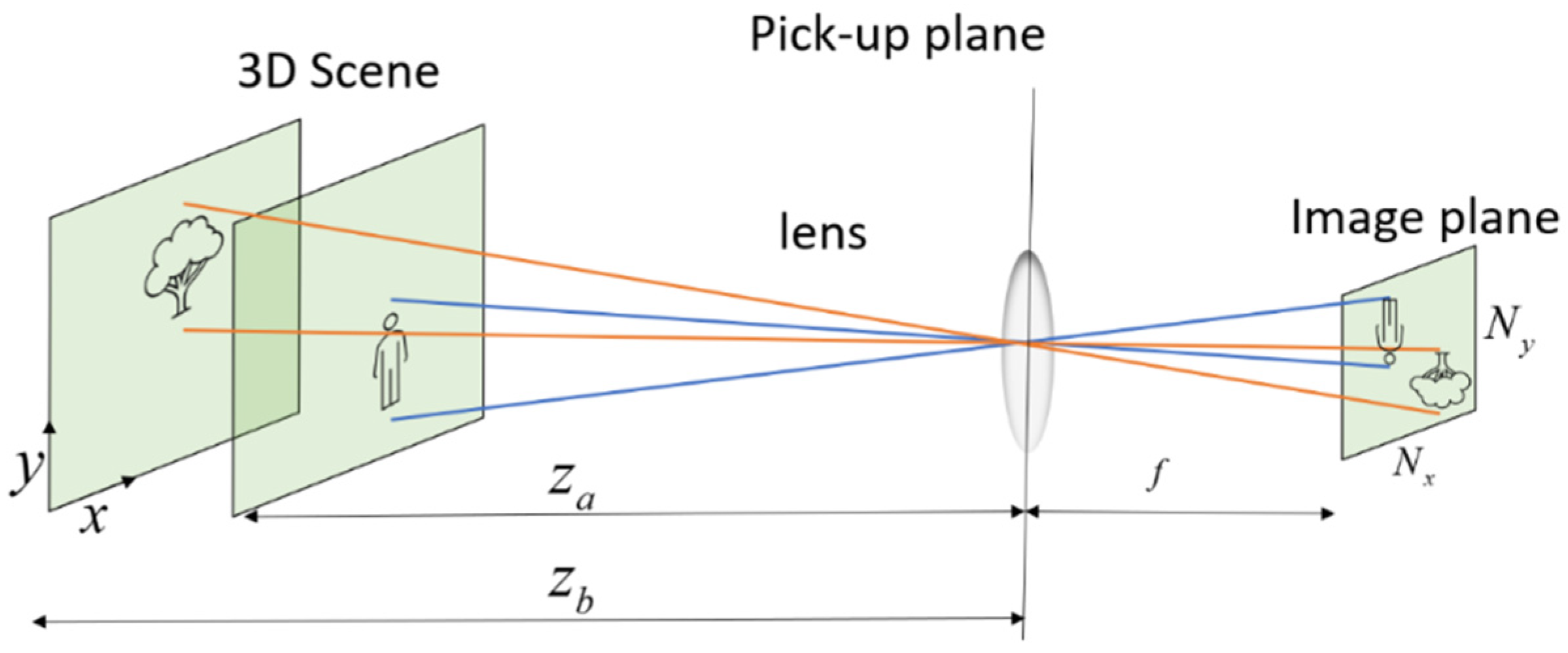
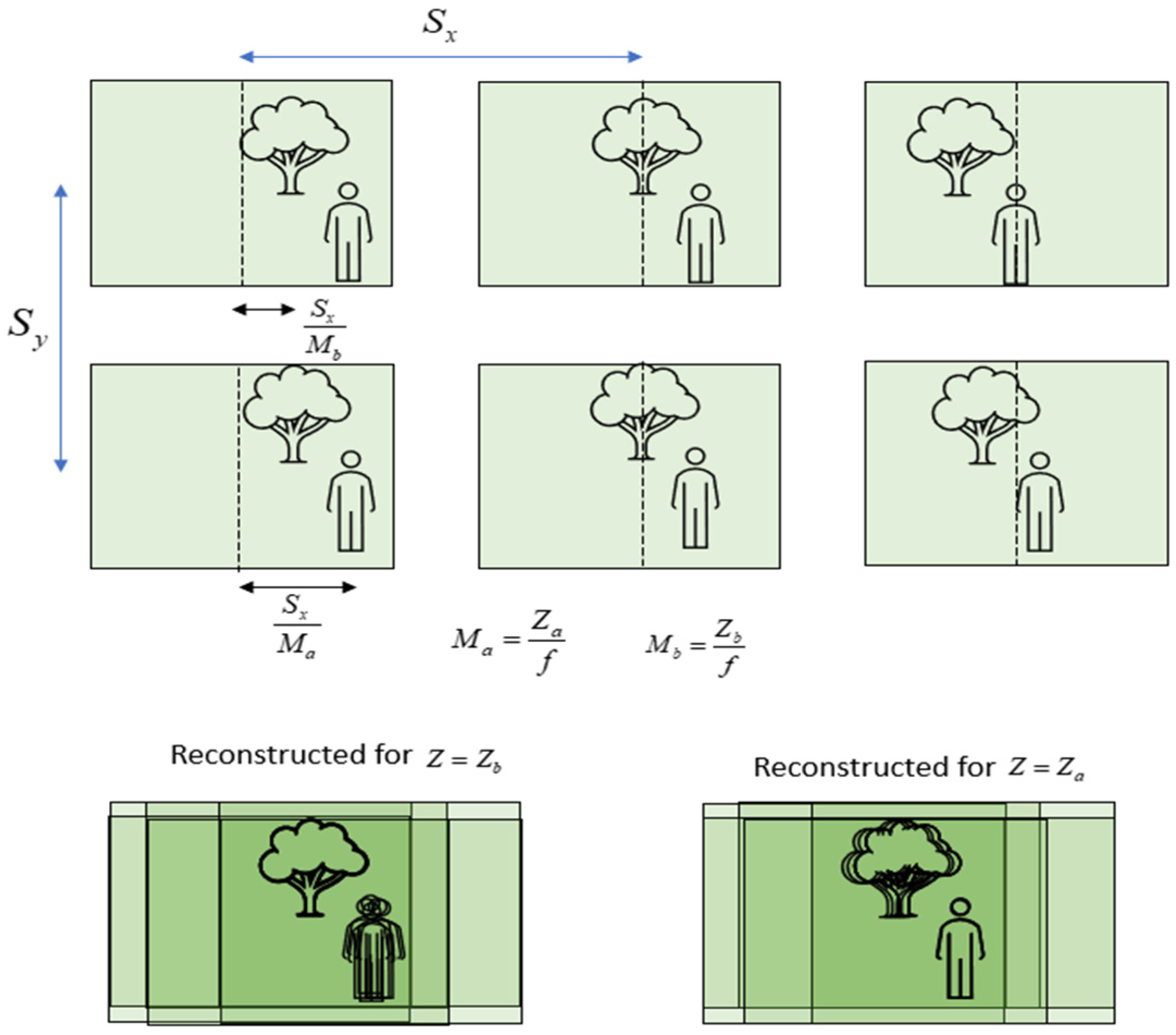
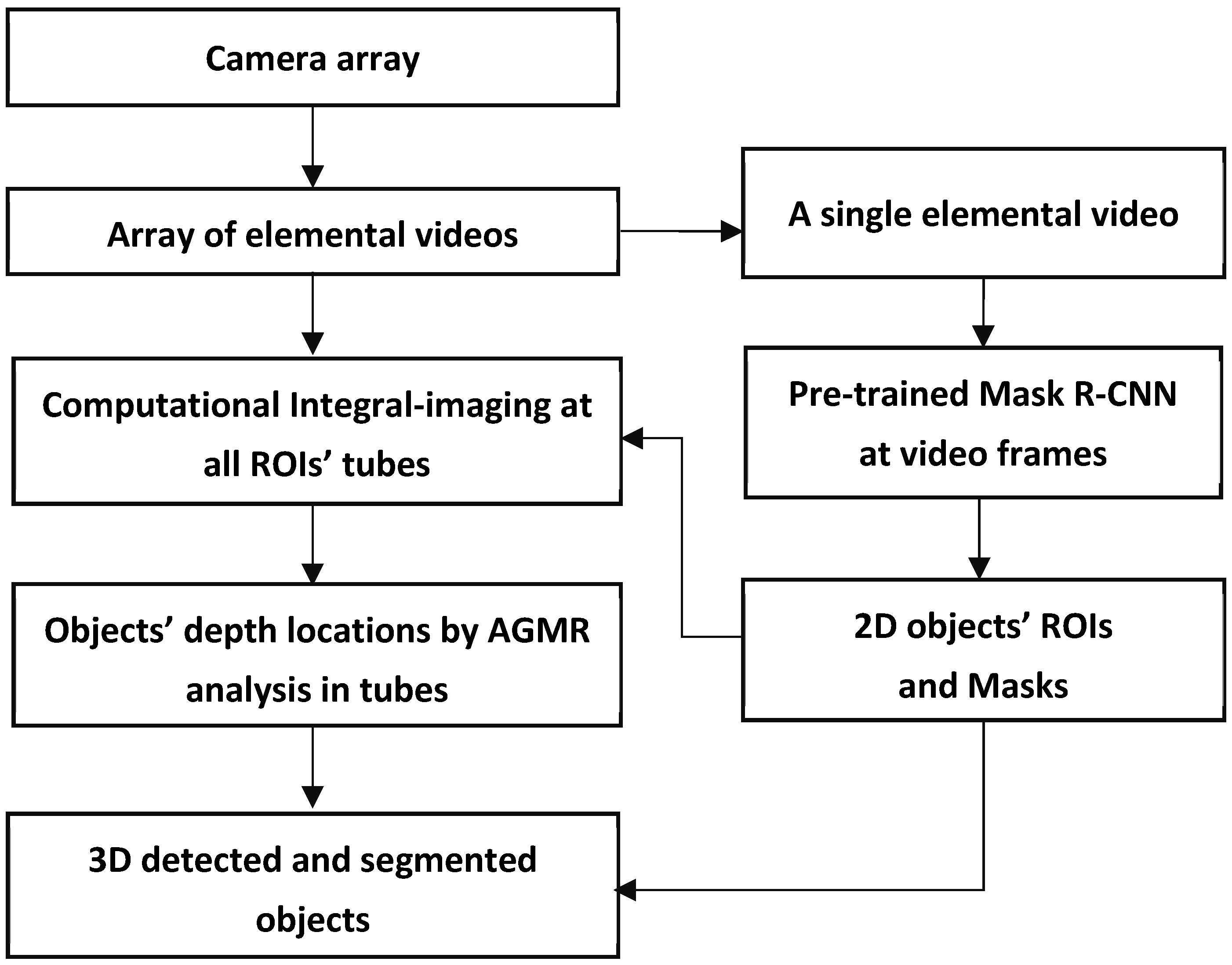


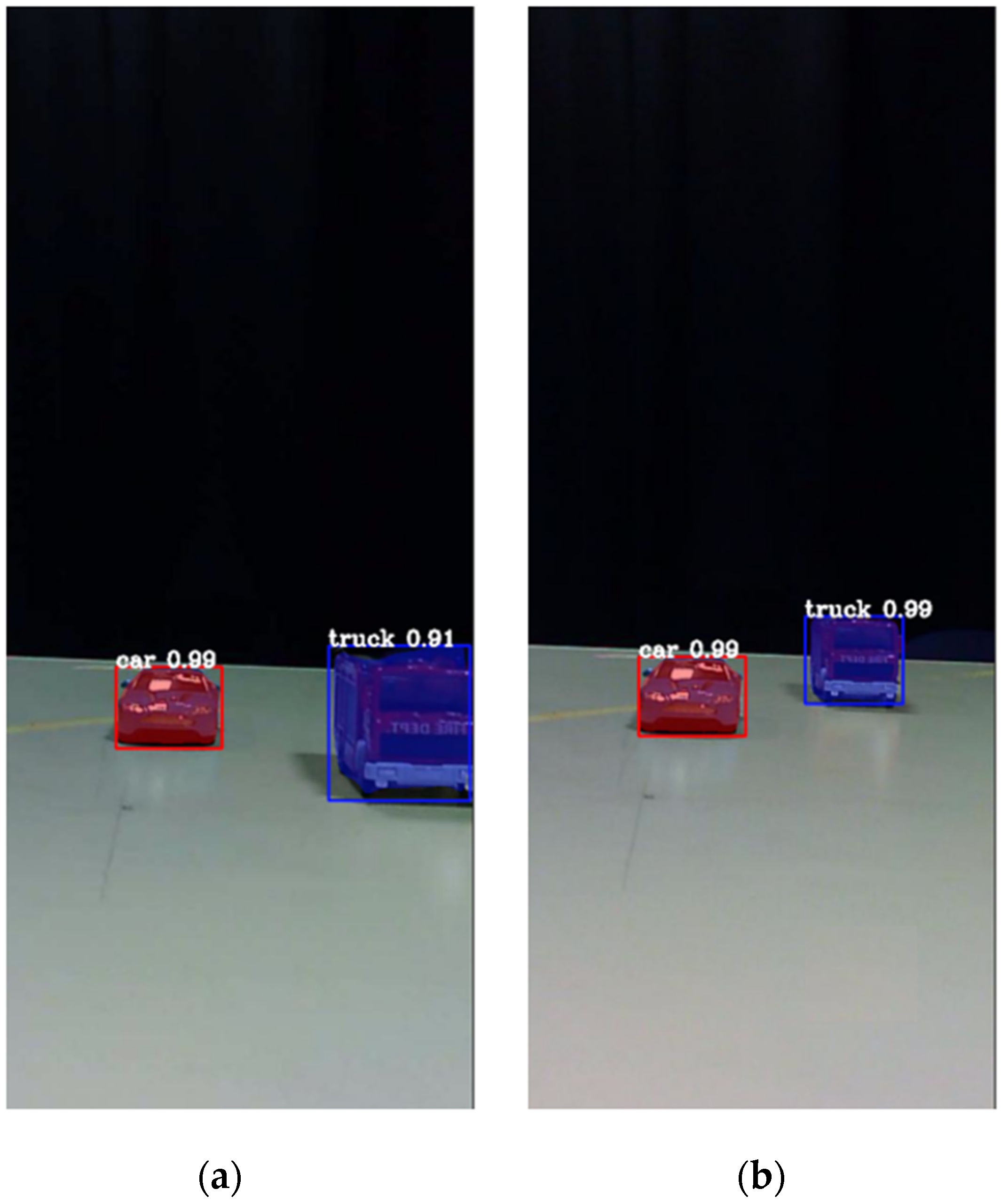

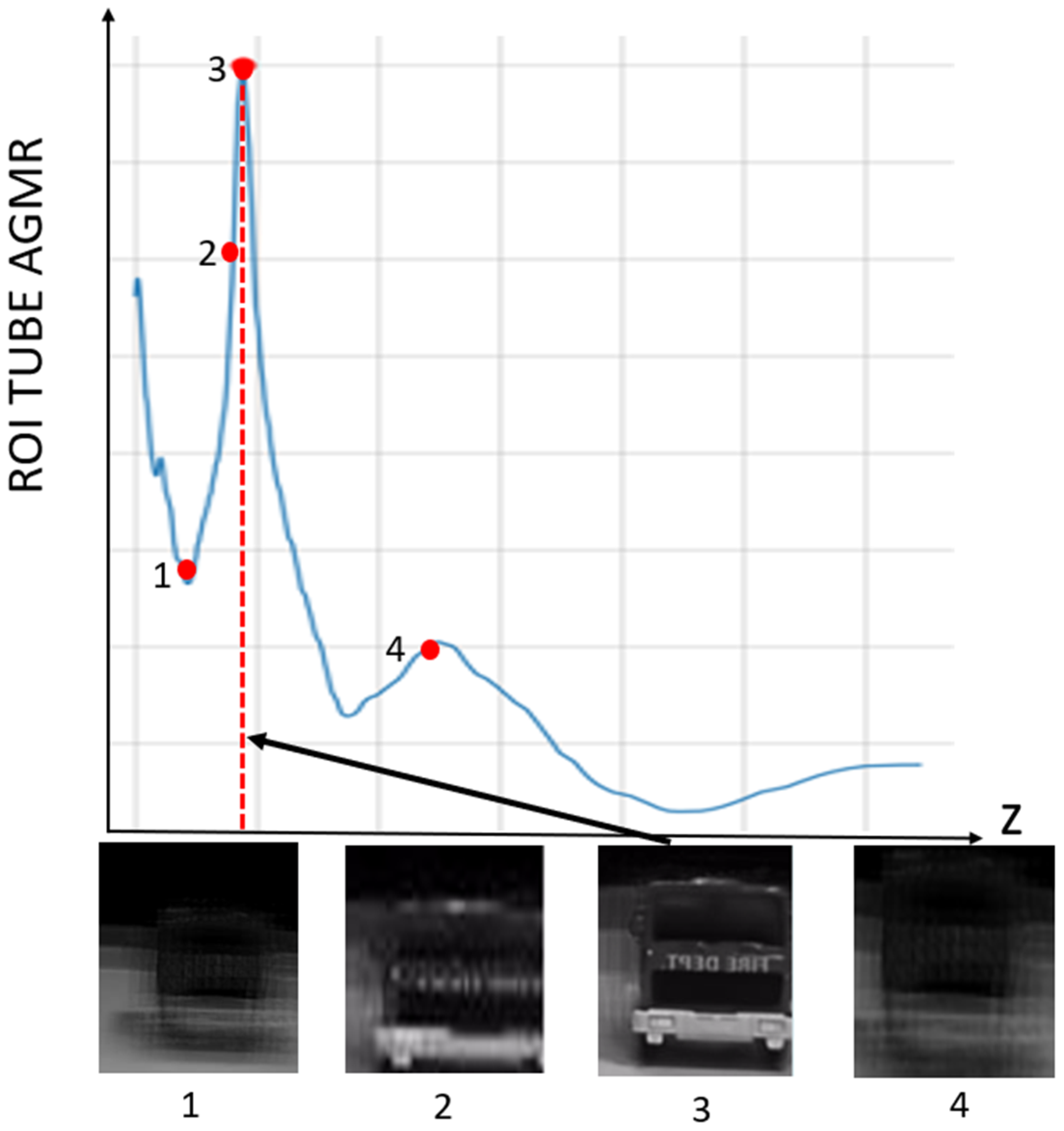


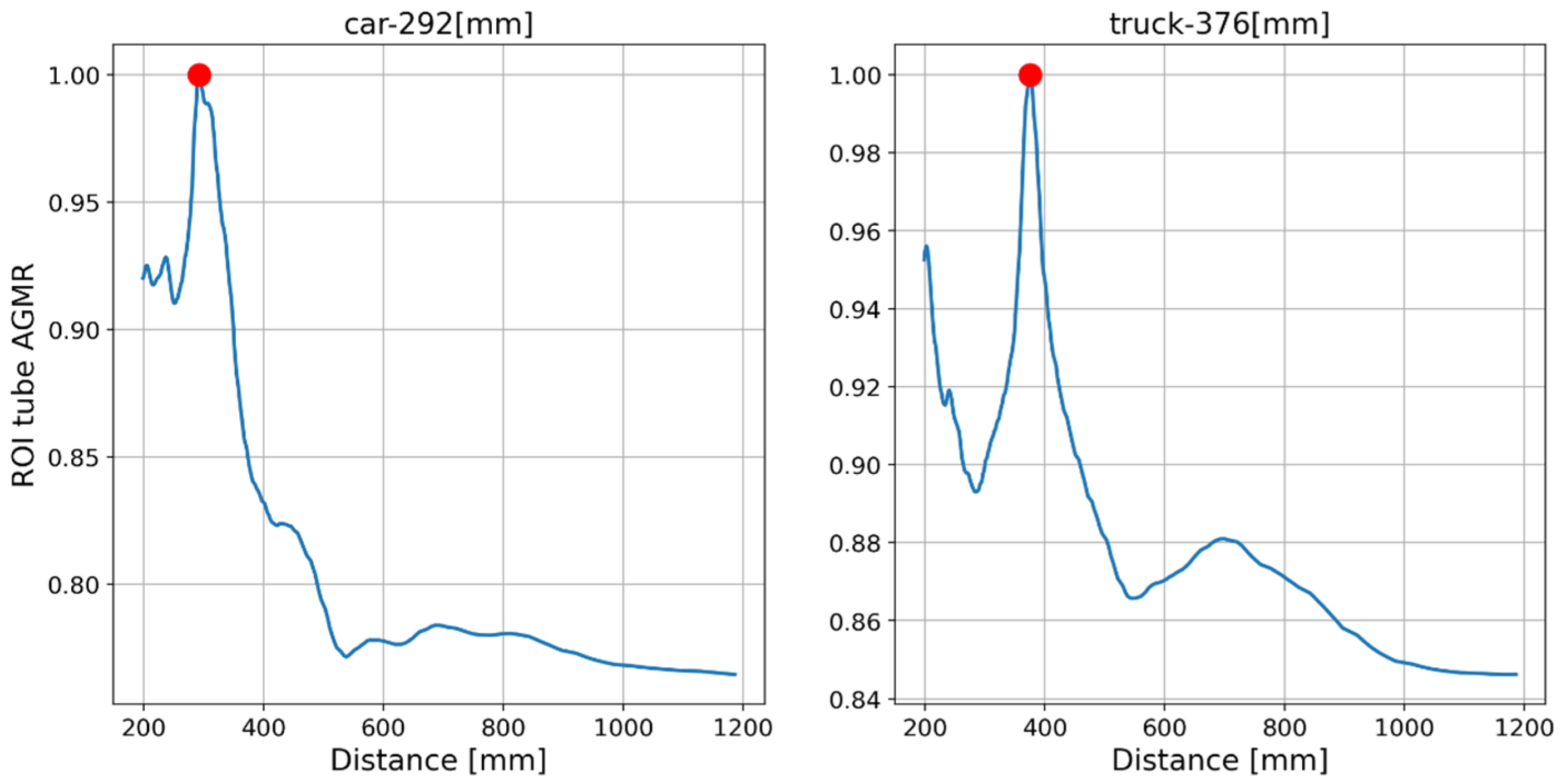
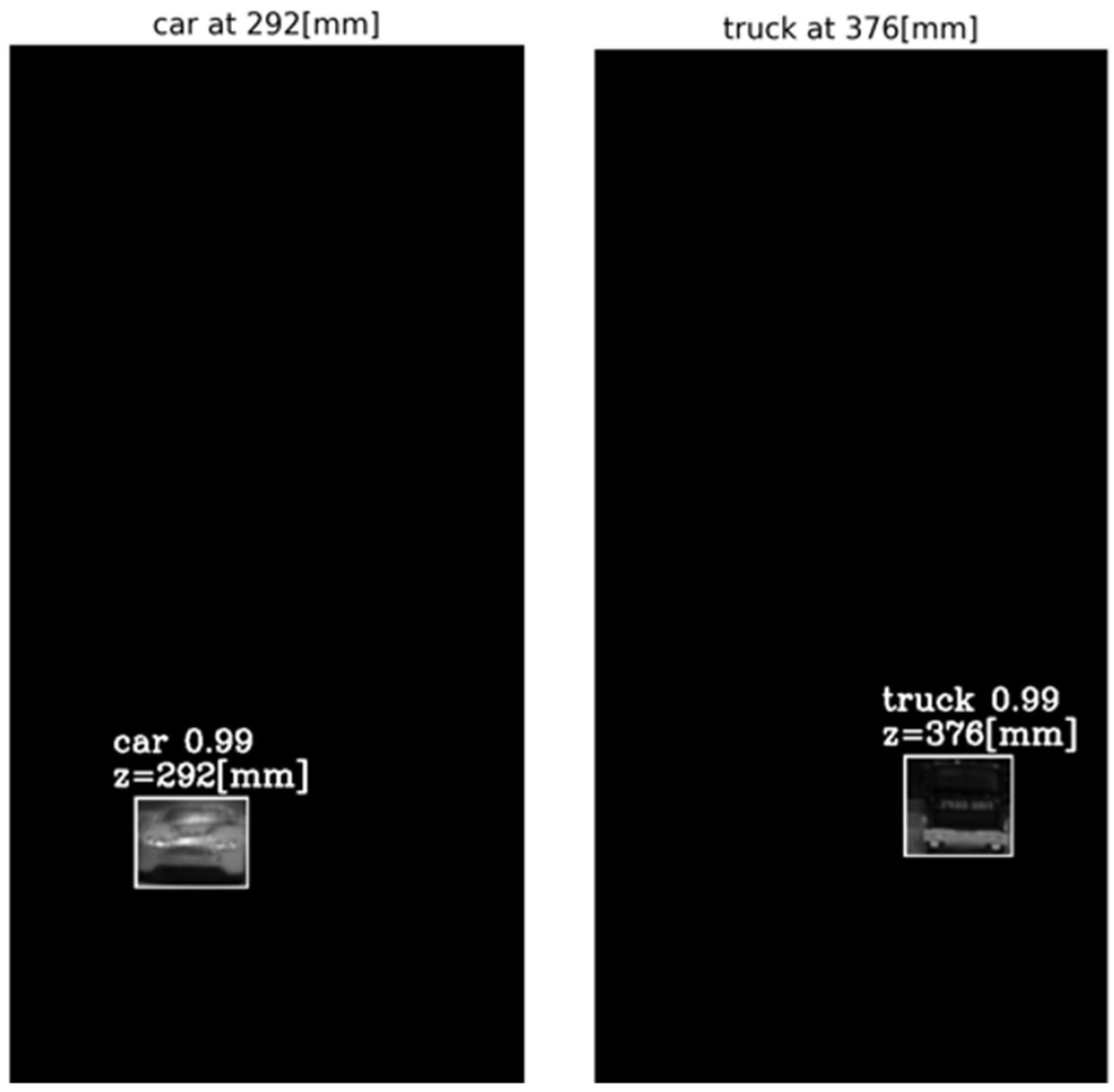
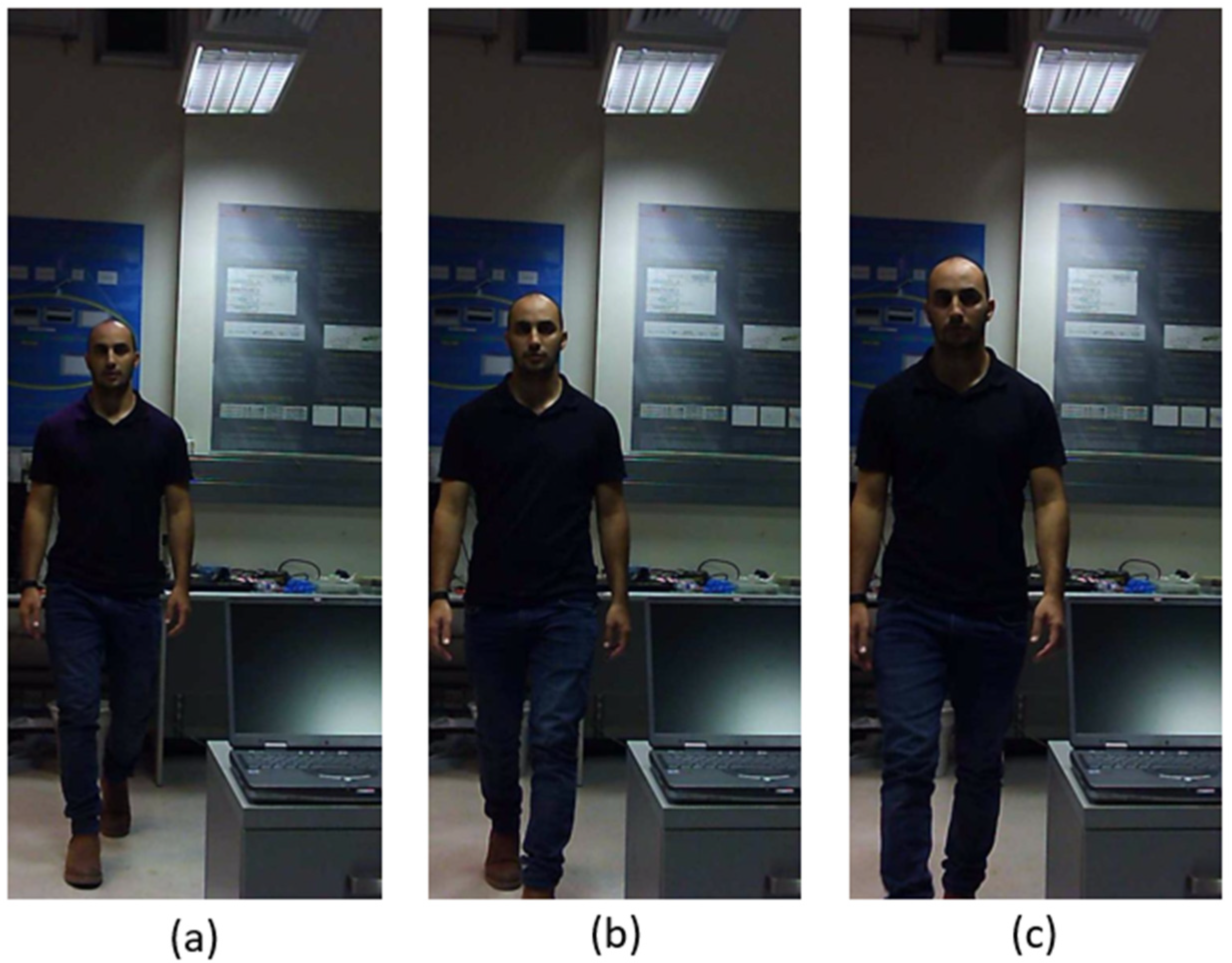
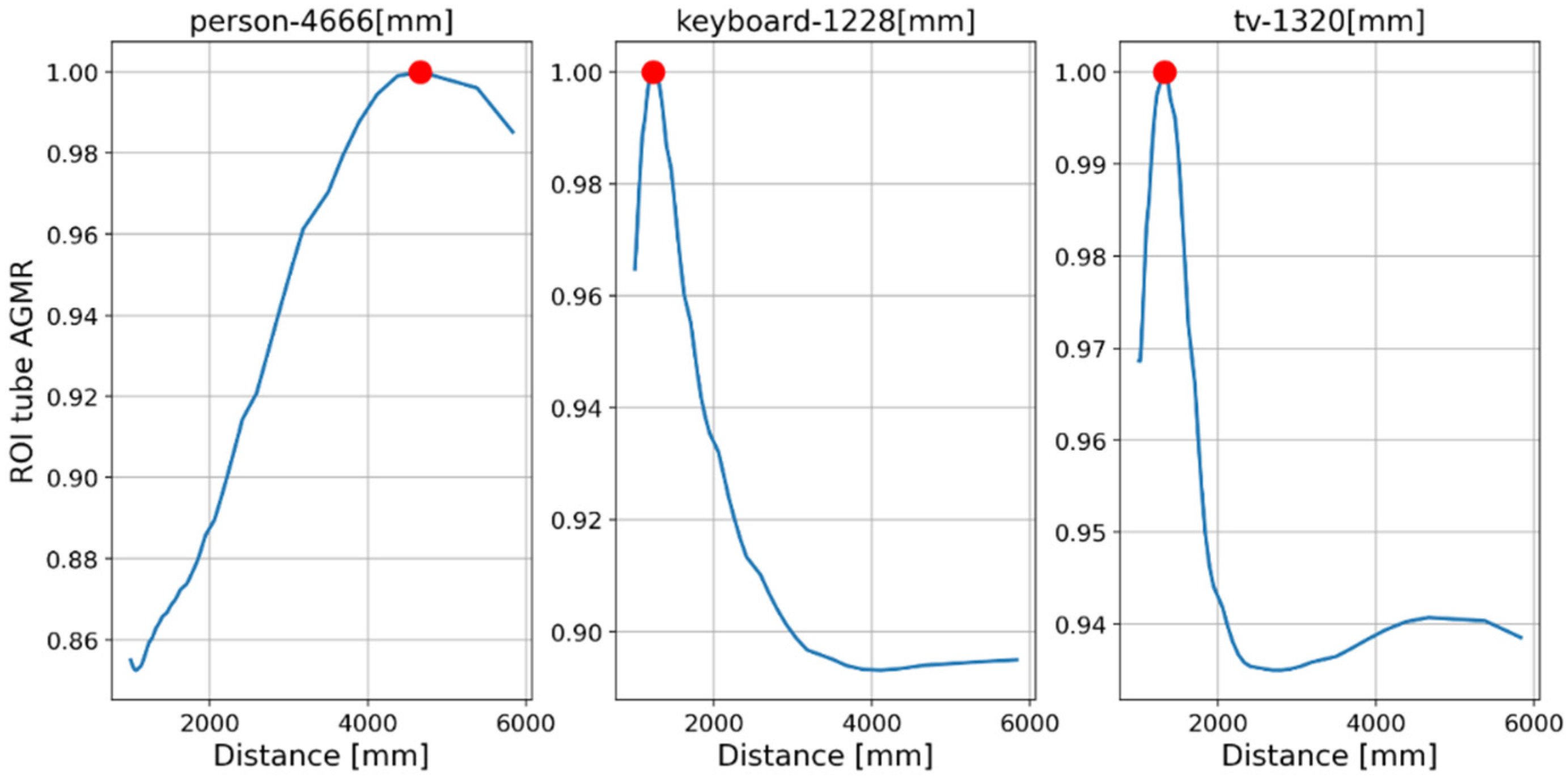
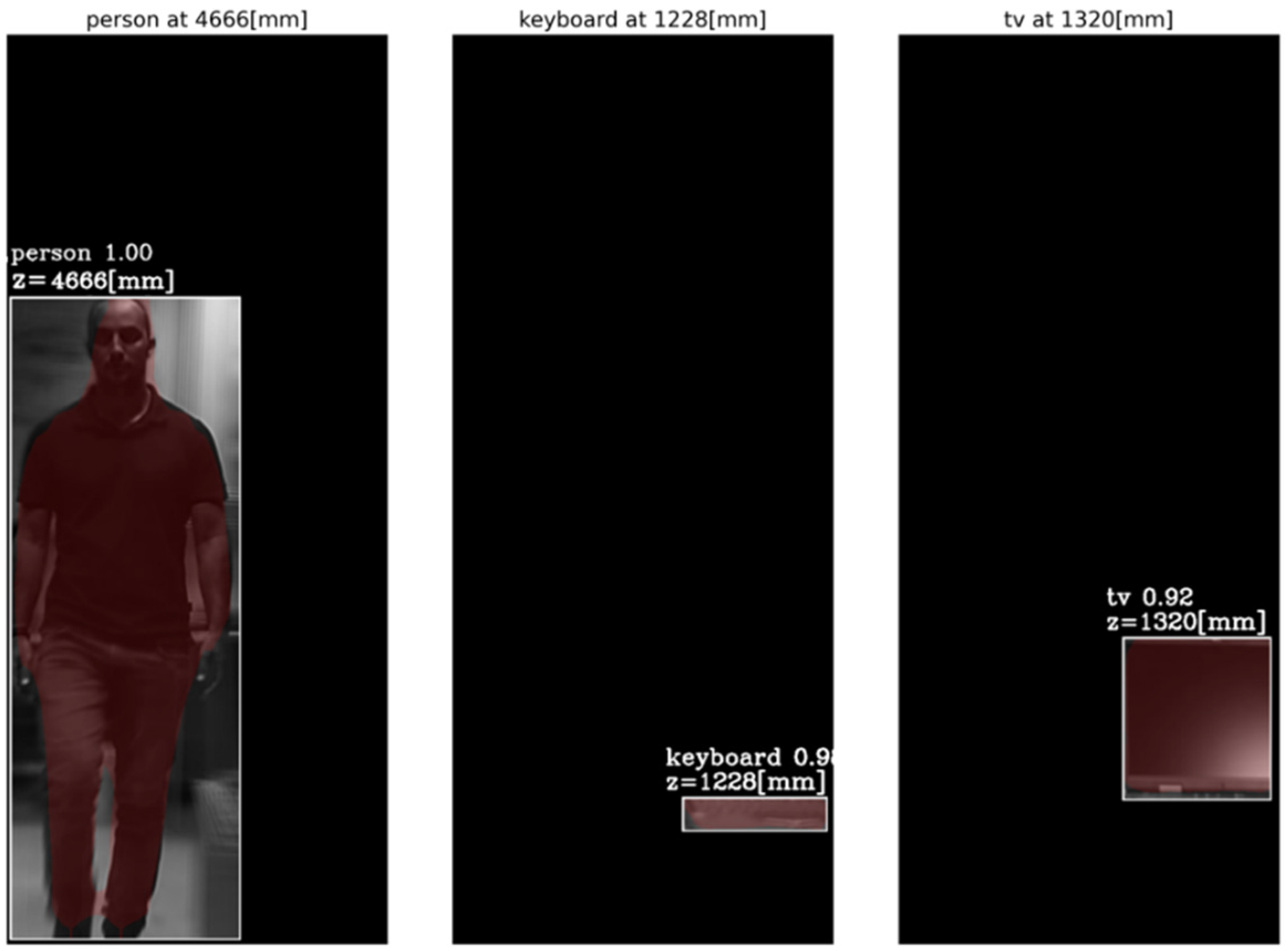

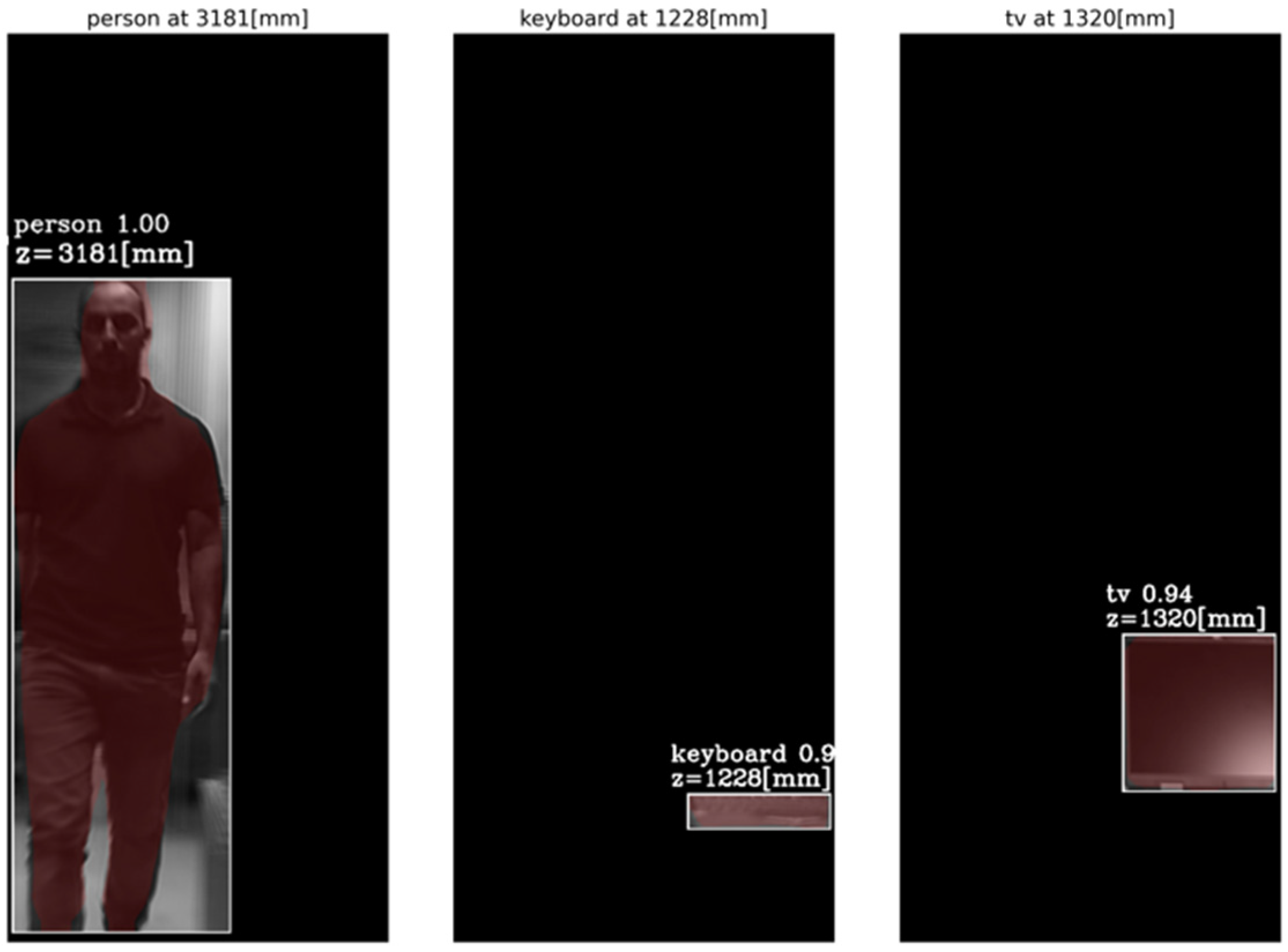
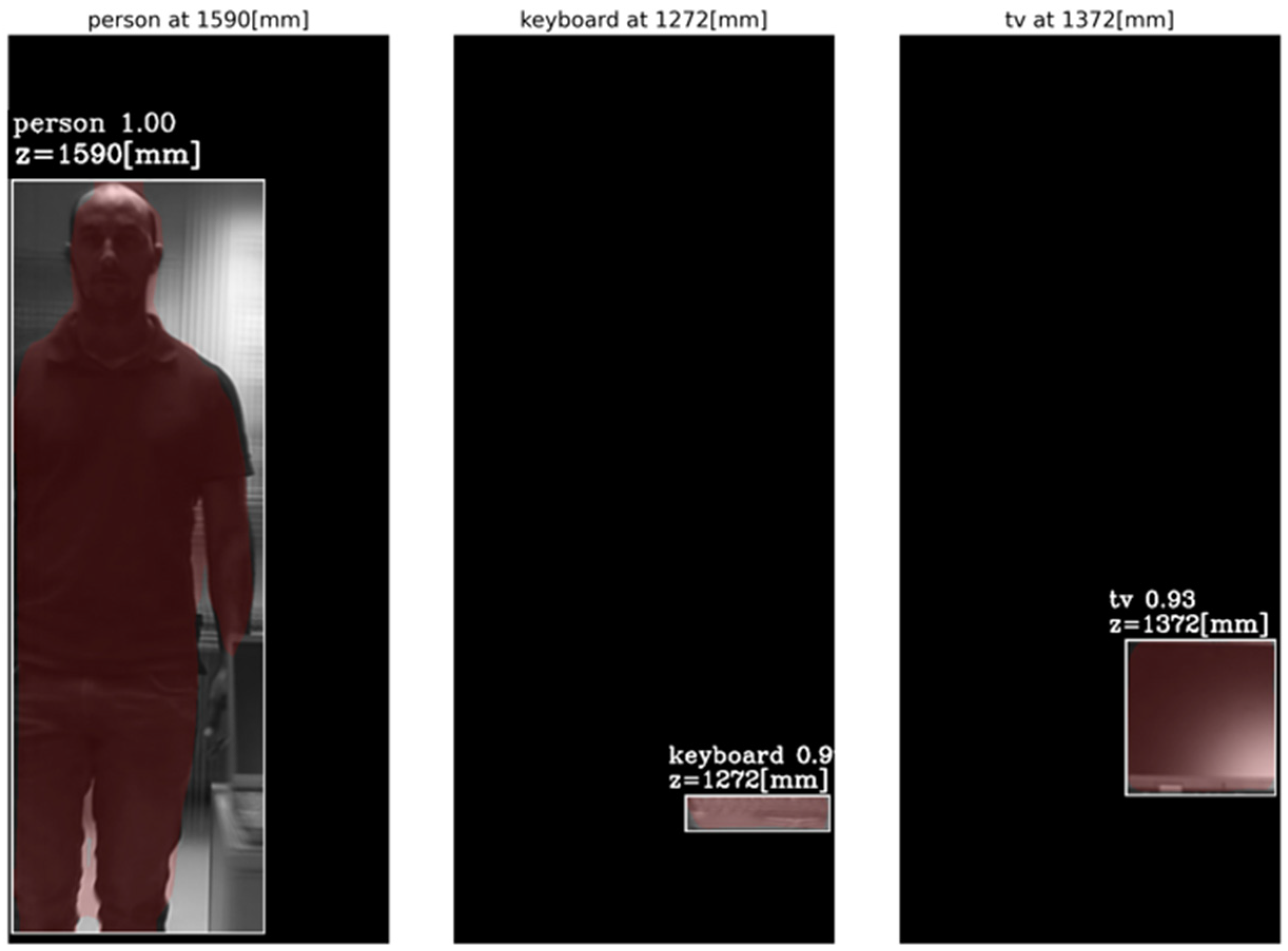

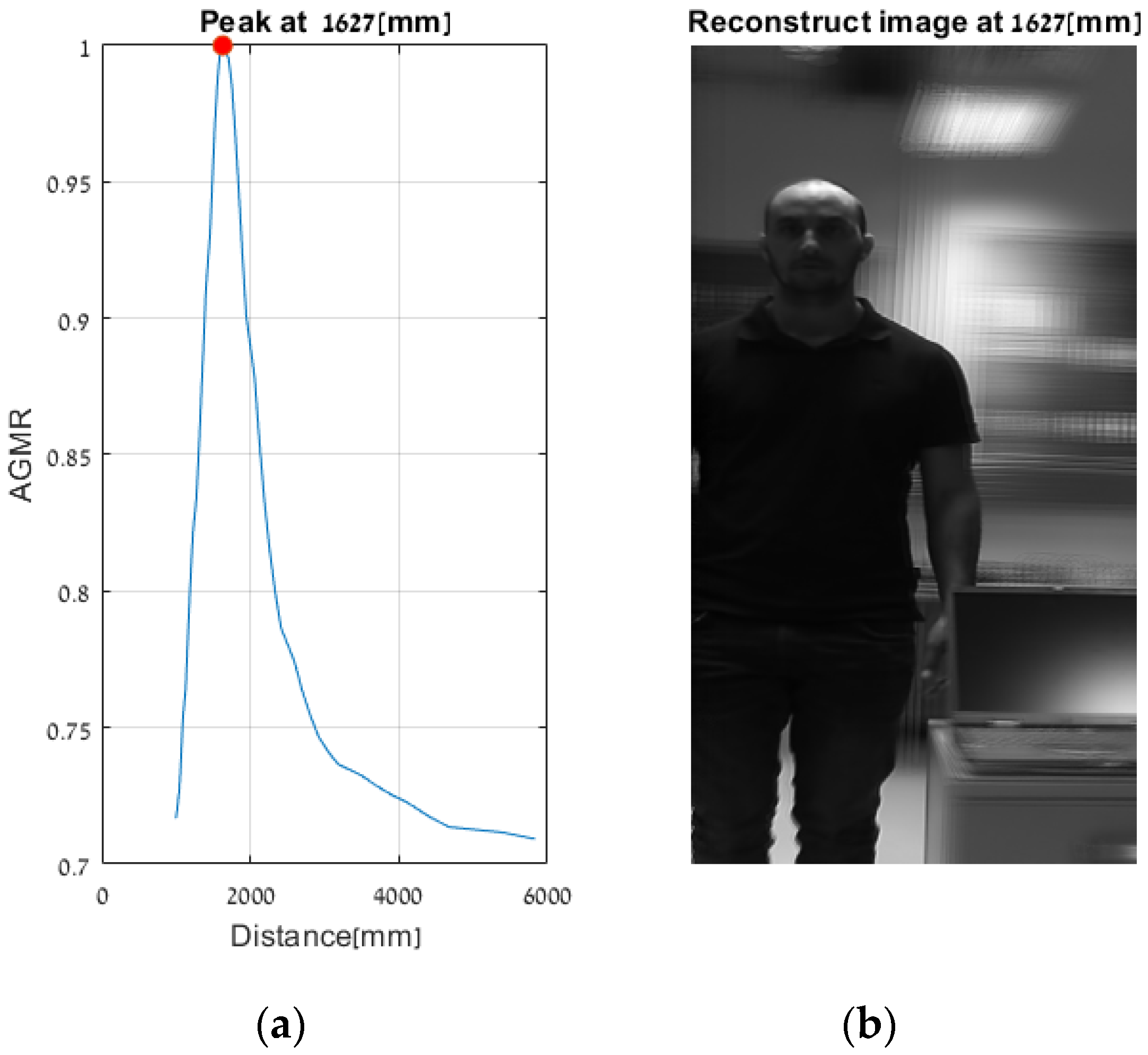
Disclaimer/Publisher’s Note: The statements, opinions and data contained in all publications are solely those of the individual author(s) and contributor(s) and not of MDPI and/or the editor(s). MDPI and/or the editor(s) disclaim responsibility for any injury to people or property resulting from any ideas, methods, instructions or products referred to in the content. |
© 2023 by the authors. Licensee MDPI, Basel, Switzerland. This article is an open access article distributed under the terms and conditions of the Creative Commons Attribution (CC BY) license (https://creativecommons.org/licenses/by/4.0/).
Share and Cite
Kadosh, M.; Yitzhaky, Y. 3D Object Detection via 2D Segmentation-Based Computational Integral Imaging Applied to a Real Video. Sensors 2023, 23, 4191. https://doi.org/10.3390/s23094191
Kadosh M, Yitzhaky Y. 3D Object Detection via 2D Segmentation-Based Computational Integral Imaging Applied to a Real Video. Sensors. 2023; 23(9):4191. https://doi.org/10.3390/s23094191
Chicago/Turabian StyleKadosh, Michael, and Yitzhak Yitzhaky. 2023. "3D Object Detection via 2D Segmentation-Based Computational Integral Imaging Applied to a Real Video" Sensors 23, no. 9: 4191. https://doi.org/10.3390/s23094191





